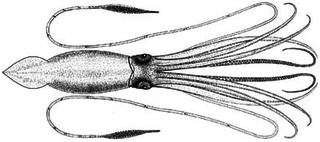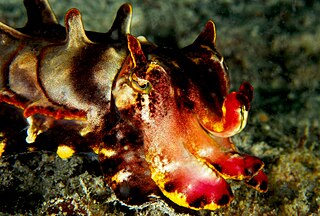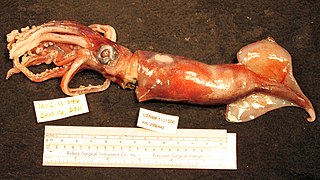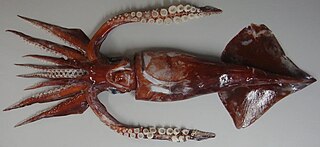
The giant squid is a species of deep-ocean dwelling squid in the family Architeuthidae. It can grow to a tremendous size, offering an example of abyssal gigantism: recent estimates put the maximum size at around 12–13 m (39–43 ft) for females and 10 m (33 ft) for males, from the posterior fins to the tip of the two long tentacles. The mantle of the giant squid is about 2 m long, and the length of the squid excluding its tentacles rarely exceeds 5 m (16 ft). Claims of specimens measuring 20 m (66 ft) or more have not been scientifically documented.

Coleoidea or Dibranchiata is one of the two subclasses of cephalopods containing all the various taxa popularly thought of as "soft-bodied" or "shell-less". Unlike its extant sister group Nautiloidea, whose members have a rigid outer shell for protection, the coleoids have at most an internal shell called cuttlebone or gladius that is used for buoyancy or as muscle anchorage. Some species, notably incirrate octopuses, have lost their internal shell altogether, while in some it has been replaced by a chitinous support structure.

The Mastigoteuthidae, also known as whip-lash squid, are a family of small deep-sea squid. Approximately 20 known species in six genera are represented, with members found in both the mesopelagic and bathypelagic zone of most oceans. Originally described by Verill in 1881, it was later lowered by Chun (1920) to a subfamily (Mastigoteuthinae) of the Chiroteuthidae. However, Roper et al. (1969) raised it back to the family level, and this has not been changed since. The taxonomy of this family is extremely unstable, and there have been at times one genus, two genera and four subgenera(Salcedo-Vargas & Okutani, 1994), two genera and several 'groups', five genera and one species with an uncertain placement, or six genera.

Doryteuthis plei, also known as the slender inshore squid or arrow squid, is a medium-sized squid belonging to the family Loliginidae. It occurs abundantly in coastal waters of the Atlantic Ocean, from Argentina northward to North Carolina.

Metasepia pfefferi, also known as the flamboyant cuttlefish, is a species of cuttlefish occurring in tropical Indo-Pacific waters off northern Australia, southern New Guinea, as well as numerous islands of the Philippines, Indonesia and Malaysia.

Magnapinna pacifica is a species of bigfin squid known only from three immature specimens; two caught at a depth of less than 300 m (980 ft) and one from a fish stomach. M. pacifica is the type species of the genus Magnapinna. It is characterised primarily by its proximal tentacles, which are wider than adjacent arms and bear numerous suckers.

Promachoteuthis sloani is a species of squid from the northern Atlantic Ocean. It was known from only three dead specimens until 2024 when a live specimen was observed and photographed in the Nazca Ridge. Very little is understood of its biology. P. sloani is characterised by several morphological features: nuchal fusion is absent between the head and mantle, the arms generally bear 3–4 series of suckers, and papillae are present on the tentacles.

Idioteuthis cordiformis is a species of whip-lash squid found in tropical regions of the west Pacific Ocean. The species is commonly known as the 'love-heart squid' because the species name cordiformis is Latin for 'heart shaped'. Recently, this species has been found to consume small birdbeak dogfish.

Chtenopteryx sicula, also known as the comb-finned squid or toothed-fin squid, is a species of squid native to at least the Mediterranean Sea. It is characterised by several distinct morphological features: ocular photophores are present but visceral photophores are absent, arm suckers are arranged in at least 4 series distally, and club suckers are borne in more than 8 series.

Rossia palpebrosa, also known as the warty bobtail squid, is a species of bobtail squid native to the northern Atlantic Ocean.

All cephalopods possess flexible limbs extending from their heads and surrounding their beaks. These appendages, which function as muscular hydrostats, have been variously termed arms, legs or tentacles.
Notonykia africanae, the African clubhook-squid, is a species of squid in the family Onychoteuthidae. It is the type species of the genus Notonykia. While the mature size of the species is unknown, it is known to reach a mantle length of at least 180 mm. Tentacles reach approximately 70% of the mantle length, and contain 14–20 club hooks. Arms are known to reach 27–45% and 33–55% of the mantle length; each containing 50–60 suckers. The species is located in southern waters off Australia, Tasmania, New Zealand and South Africa.
Pyroteuthis margaritifera, the jewel enope squid, is a species of squid in the family Pyroteuthidae.

Illex coindetii, commonly known as the southern shortfin squid or broadtail shortfin squid, is a species of neritic squids in the family Ommastrephidae. They are found in the Mediterranean Sea and on both sides of the north Atlantic Ocean.

Teuthowenia megalops, sometimes known as the Atlantic cranch squid, is a species of glass squid from the subarctic and temperate waters of the northern Atlantic Ocean. They are moderately sized squid with a maximum mantle length of 40 cm (16 in). Their very large eyes are the source for the specific name megalops. Like other members of the genus Teuthowenia, they are easily recognizable by the presence of three bioluminescent organs (photophores) on their eyeballs.
Gonatopsis okutanii is a species of squid from the family Gonatidae from the northern Pacific Ocean. It is of uncertain taxonomic status, the presence of remnant tentacles on spent females indicate that this species does not belong in the genus Gonatopsis and the differences between this species and Gonatus makodai have led to some authorities stating that G. okutanii is a junior synonym of Eogonatus tinro. However the World Register of Marine Species still recognises Gonatopsis okutanii as the valid name for this taxon.

Ornithoteuthis antillarum, the Atlantic bird squid, is a species of flying squid from the family Ommastrephidae which is found in the warmer waters of the Atlantic Ocean. This species is an important component of the diet of many species of fish and of cetaceans. It is taken as a bycatch in fisheries but has the potential to be commercially important if appropriate fishing methods can be developed.

The Antarctic flying squid is a species of squid from the subfamily Todarodinae of the family Ommastrephidae, a family of pelagic squid from the order Oegopsida. It has a circumglobal distribution in the seas around the lower latitudes of the Southern Ocean.
The little flying squid is a species of squid, one of the arrow squids of the genus Todarodes, in the subfamily Todarodinae of the flying squid family Ommastrephidae. It is a small species from the waters around northern Australia and Indonesia.














